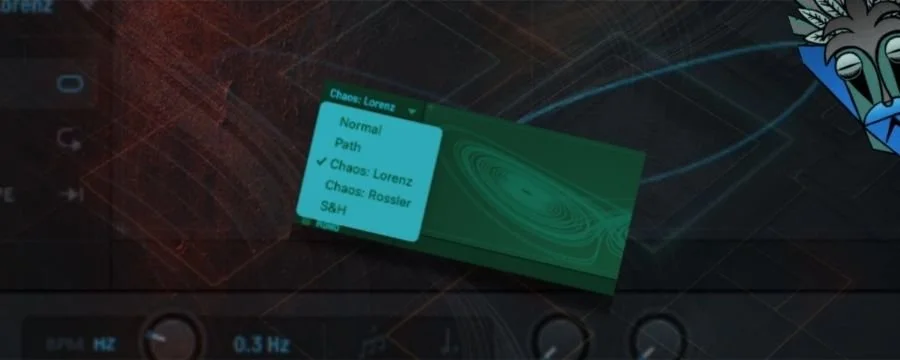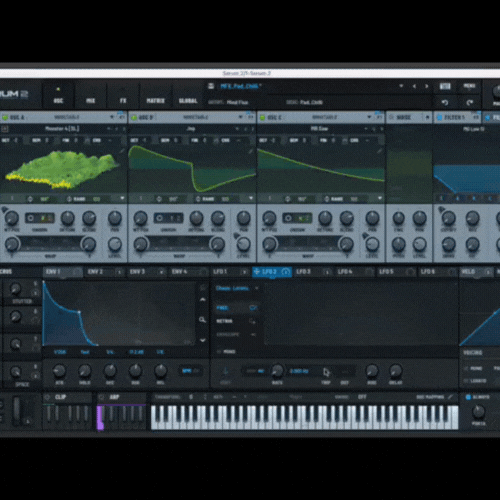Chaos LFOs in Serum 2: Controlled Randomness for Analog Drift
Serum 2’s Chaos LFOs give your sound movement that’s alive but never out of control.
Instead of pure randomness, these new modulators generate motion based on mathematical attractors — systems that evolve unpredictably while remaining smooth and musical.
For techno, this means you can bring back that subtle analog imperfection digital synths often lack — gentle fluctuations that make every hit, stab, and sweep feel slightly different.
What Are Chaos LFOs?
In Serum 1, “Chaos 1” and “Chaos 2” were simple random generators — good for unpredictability but not for musical motion.
Serum 2 replaces them with a dedicated Chaos LFO section that includes a couple of selectable modes, such as Lorenz and Rossler.
Each behaves differently: Lorenz is fluid and drifting; Rossler feels cyclical but unstable; Henon adds sharper, more granular motion.
They generate continuous modulation — no stepped jumps, no hard resets — which makes them ideal for nuanced variation over time.
You can route them to any destination that benefits from natural imperfection: oscillator pitch, filter cutoff, delay time, pan, even reverb parameters.
Why Use Chaos LFOs in Techno Production
Analog gear naturally drifts. Pitch, filters, and timing all move microscopically, giving warmth and realism.
Chaos LFOs recreate that behaviour inside Serum 2 without randomizing everything uncontrollably.
Use Cases for Producers:
Oscillator Drift: Assign a slow Chaos LFO to fine-tune or unison detune to simulate unstable analog oscillators.
Filter Breathing: Modulate cutoff or resonance slightly so the tone “breathes” each bar.
Spatial Motion: Send Chaos to pan or reverb mix to keep space shifting naturally.
Percussive Variation: Add tiny chaos modulation to amp env attack or transient shaper drive — no two hits sound identical.
“It’s randomness with intent — imperfection that still grooves.”
How to Set It Up
Getting started with Chaos LFOs in Serum 2 is simple — the key is restraint and intention.
Because these modulators generate smooth, evolving motion, small changes can have a big impact.
Think of it less as adding randomness and more as introducing natural instability — the kind of subtle drift and fluctuation you’d get from analog hardware left to warm up in the studio.
Here’s how to dial it in for controlled, musical results.
Load Serum 2 and choose a sound with sustained movement — a pad, lead, or atmospheric hit.
In the mod matrix, select a Chaos LFO as your source.
Choose your mode — Lorenz for slow drift or Rossler for looping chaos.
Assign it to a subtle parameter (filter cutoff, fine tune, reverb mix).
Set a very low amount (±1 – 3%) for realism, or push it harder for experimental FX.
Optionally, mix in a Path LFO or Envelope to balance predictable and chaotic movement.
Pro Tips
Once you’ve learned the basics, Chaos LFOs start to shine when combined with other modulators.
They’re not just about drift — they’re about movement that reacts, evolves, and interacts with your sound design choices.
By layering, shaping, and syncing chaos in creative ways, you can turn subtle instability into a defining part of your techno sound.
Try these ideas to push the modulation system even further.
Combine Chaos + LFO: Use a slow Path LFO to modulate the depth of a Chaos LFO. This makes the randomness fade in and out across phrases.
Layer Multiple Chaos Sources: Two different Chaos LFOs on separate parameters add complex, organic interactions.
Freeze or Reset: For rhythmic control, enable Restart via Gate so the chaos restarts each note — great for synced variations.
Visual Feedback: Open the LFO display to see the motion curve — each mode’s movement has its own rhythm and texture.
Closing Thoughts
Chaos LFOs bridge precision and unpredictability.
They let you keep the mechanical drive of techno while adding the subtle instability that makes music feel human.
Once you start integrating them, even static loops begin to breathe.
“Controlled chaos is the soul of modern techno sound design.”




